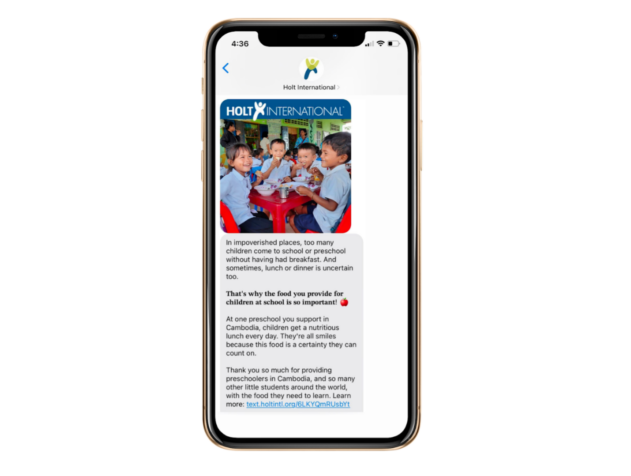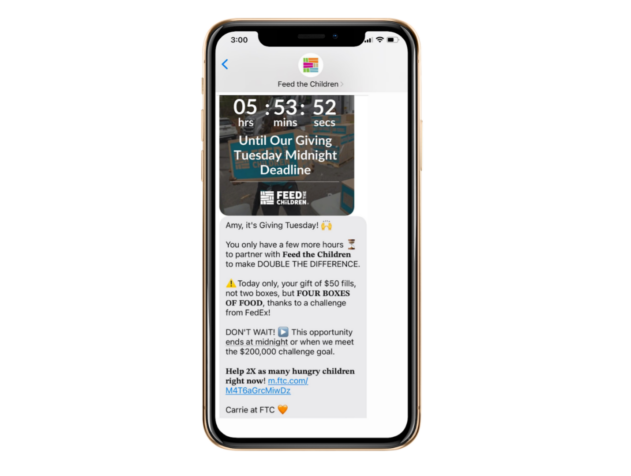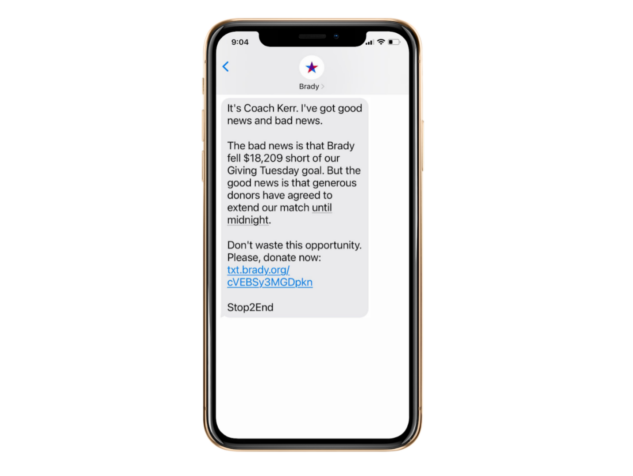Your Guide to a Winning GivingTuesday Text Messaging Strategy

Nonprofit texting has grown up fast. What was once seen as a new fundraising channel is now a proven revenue driver and one of the most personal and important channels available to nonprofits and educational institutions.
Nonprofit texting continues to prove itself as both a high-ROI channel and a relationship builder. Tatango’s latest Nonprofit Text Messaging Insights Report covered 138 million texts sent from 22 organizations, which drove 2.8 million clicks and 43,853 donations. These results show how powerful well-timed messaging can be during critical giving moments like GivingTuesday.
Many teams still ask an important question: What is the right strategy to inspire donors through text on GivingTuesday? This post explains when to text, what types of messages to send, and how to structure a timeline that engages supporters before, during, and after the big day. By the end, you will have a plan to connect with donors at the right moments to maximize your GivingTuesday results.
For more data on optimizing your engagement with donors, look at the special report: GivingTuesday x Blackbaud Institute
Why Texting Works on GivingTuesday
GivingTuesday is fast, emotional, and mobile. Donors respond in the moment, which is exactly where texting excels. With 90% of texts opened within 3 minutes of being received, messages reach supporters quickly and drive them to mobile-optimized donation pages. During GivingTuesday 2024, texting delivered strong conversion and ROI performance, making it an ideal channel for this important, time-sensitive fundraising moment.
How Many Texts Should You Send?
In 2024, nonprofits sent an average of seven texts in December, nearly triple a typical month. But frequency alone does not guarantee success. Balance and timing matter more. Programs that perform best use a thoughtful cadence of cultivation, engagement, and fundraising. That balance ensures donors see value in every message, not only appeals.
For GivingTuesday, approach your text messaging strategy in phases:
- Prepare your supporters
- Activate them at peak hours
- Follow up with gratitude and proof of impact
The timeline below centers on optimizing the donor experience and getting the highest performance for your organization.
The GivingTuesday Text Messaging Timeline
First Half of November: Report Back on Donor Impact
Goal: Donor cultivation
Before asking for another gift, show how previous donations created an impact. Don’t assume your supporters are aware of the impact your organization has delivered or challenges that you’ve faced over the past year. This first touchpoint in November helps donors feel informed, appreciated, and emotionally connected ahead of the giving season. Stories about real results can build trust and readiness to give again later.
- Timing tip: Send in the late afternoon or early evening, ideally between 4 p.m. and 7 p.m., when engagement peaks and opt-out rates are lowest.

Second Half of November: Thanksgiving Cultivation
Goal: Donor stewardship
As GivingTuesday approaches, a short, heartfelt Thanksgiving message can express gratitude at a moment when many people are already reflecting on what matters to them. This touchpoint should focus purely on appreciation, not solicitation.
- Timing tip: Send the day before Thanksgiving or the morning of Thanksgiving for best visibility without interrupting family time.
Day of GivingTuesday: Launch, Remind, and Close Strong
Goal: Fundraising and activation at peak giving moments
Here’s a recommended GivingTuesday cadence.
- Morning launch, ideally 9 a.m. to 11 a.m.: Use a compelling MMS to visualize impact, aid in storytelling, or share a timely opportunity such as a match. MMS fundraising texts typically drive 25% higher conversions than text-only SMS throughout the year, but on GivingTuesday that performance gap doubles, with MMS converting at roughly twice the rate of SMS.

- Late-afternoon reminder, typically 4 p.m. to 5 p.m.: This window has repeatedly delivered strong ROI and conversion performance for fundraising, as supporters are winding down the workday and checking phones.

- Final-hours push, between 8 p.m. and 9 p.m.: Urgency and deadlines are clear. This window can carry strong conversions, although opt-outs rise slightly in the latest hour. Reserve the latest push for high-importance moments such as an expiring match or closing gap to goal.
A useful sequencing pattern is to pair an MMS fundraising text with a follow-up SMS within a short window. When nonprofits used an MMS fundraising message followed by an SMS within three days, conversion rates rose by 53% and ROI increased by 46%. For GivingTuesday, compress the follow-up to the same day so the sequence aligns with morning launch and evening close.
Day After GivingTuesday: Keep the Momentum
Goal: Gratitude, results, and optional continuation if an offer extends
Performance often remains strong the day after, with a 2.5 times higher conversion rate compared to the day before GivingTuesday according to the Insights Report. Communicate thanks, report early totals, and, if an offer or match legitimately extends, invite those who did not give to participate. Many donors appreciate a brief window to act after the GivingTuesday rush, particularly if they missed the deadline or saw the results and want to help you finish strong.

Building Trust Through Balance
Successful programs balance fundraising with engagement and cultivation throughout the year. In 2024, the overall mix of nonprofit texting was evenly split between fundraising and non-fundraising. That balance is intentional and critical. Engagement and cultivation build trust, highlight outcomes, and create an emotional connection to your organization which fuels the readiness to power fundraising on high-stakes days.
After GivingTuesday, continue to show what donors made possible ahead of your late-December fundraising texts.
The Bottom Line
GivingTuesday is a sprint that also sets the tone for year-end. Programs that perform best are those that prepare supporters with early cultivation, activate them at the right day-of moments, and follow with timely gratitude and proof of impact.
Recap:
- First half of November: Report on donor impact
- Second half of November: Express thanksgiving and reinforce the relationship
- On GivingTuesday: Coordinate morning launch, an afternoon reminder, and final-hours urgency
- The day after: Consolidate momentum with thanks and results.
- The week after: Retain and deepen relationships through meaningful follow-up
Texting delivers reach and immediacy. Strategy delivers outcomes. With the timeline and principles above, your organization can create a GivingTuesday plan that feels good to donors and performs where and when it counts.



